
Benin, officially the Republic of Benin, and formerly Dahomey, is a country in West Africa. It is bordered by Togo to the west, Nigeria to the east, Burkina Faso to the north-west, and Niger to the north-east. The majority of its population lives on the southern coastline of the Bight of Benin, part of the Gulf of Guinea in the northernmost tropical portion of the Atlantic Ocean. The capital is Porto-Novo, and the seat of government is in Cotonou, the most populous city and economic capital. Benin covers an area of 114,763 square kilometres (44,310 sq mi) and its population in 2021 was estimated to be approximately 13 million. It is a small, tropical country. It is one of the least developed, with an economy significantly dependent on agriculture, and is an exporter of palm oil and cotton. Some employment and income arise from subsistence farming.

The demographics of Benin include population density, ethnicity, education level, health of the populace, economic status, religious affiliations and other aspects of the population.
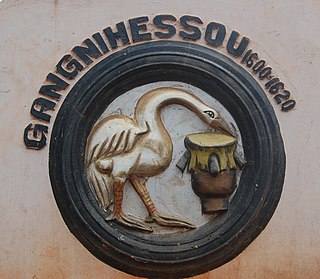
Do-Aklin or Gangnihessou or Dogbari is claimed as the founder of the Fon Kingdom of Dahomey in present-day Benin and the first person in the royal lineage of the Kings of Dahomey. In many versions he is considered the first king of Dahomey even though the kingdom was founded after his death. Very little is known about Do-Aklin and most of it is connected to folklore, but it is generally claimed that he settled a large group of Aja people from Allada on the Abomey plateau amongst the local inhabitants in c. 1620. His son Dakodonu would eventually build a palace on the plateau and began forming the Kingdom of Dahomey.

The Fon people, also called Fon nu, Agadja or Dahomey, are a Gbe ethnic group. They are the largest ethnic group in Benin found particularly in its south region; they are also found in southwest Nigeria and Togo. Their total population is estimated to be about 3,500,000 people, and they speak the Fon language, a member of the Gbe languages.
The Aja or Adja are an ethnic group native to south-western Benin and south-eastern Togo. According to oral tradition, the Aja migrated to southern Benin in the 12th or 13th century from Tado on the Mono River, and c. 1600, three brothers, Kokpon, Do-Aklin, and Te-Agbanlin, split the ruling of the region then occupied by the Aja amongst themselves: Kokpon took the capital city of Great Ardra, reigning over the Allada kingdom; Do-Aklin founded Abomey, which would become capital of the Kingdom of Dahomey; and Te-Agbanlin founded Little Ardra, also known as Ajatche, later called Porto Novo by Portuguese traders and the current capital city of Benin.
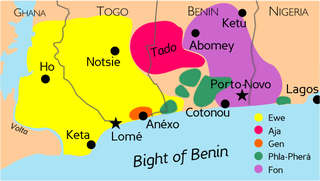
The Gbe languages form a cluster of about twenty related languages stretching across the area between eastern Ghana and western Nigeria. The total number of speakers of Gbe languages is between four and eight million. The most widely spoken Gbe language is Ewe, followed by Fon. The Gbe languages were traditionally placed in the Kwa branch of the Niger–Congo languages, but more recently have been classified as Volta–Niger languages. They include five major dialect clusters: Ewe, Fon, Aja, Gen (Mina), Gun and Phla–Pherá.

The Anlo Ewe are a sub-group of the Ewe people of approximately 6 million people, inhabiting southern Togo, southern Benin, southwest Nigeria, and south-eastern parts of the Volta Region of Ghana; meanwhile, a majority of Ewe are located in the entire southern half of Togo and southwest Benin. They are a patrilineal society governed by a hierarchal, centralized authority. Their language is a dialect of the Ewe language, itself part of the Gbe language cluster. The Ewe religion is centered on the Supreme God, Mawu and several intermediate divinities. Christianity has been accepted in every part of Anlo Ewe land, with a minority of people still practicing traditional Vodun beliefs. The Vodu religion is slowly becoming a previous religion among the Anlo Ewes, with the youth of the community today practicing Christianity much more. However, those who still practice the Vodu religion also believe their tradition is a factor that keeps integrity and probit, while Christianity stands to pave way for integrity, honesty and probity to be washed away as years go by. It is for this reason that some Anlo Ewe people do away with Christianity when it comes to issues of accountability.
The Phla–Pherá (Xwla–Xwela) languages form a possible group of Gbe languages spoken mainly in southeastern and southwestern Benin; some communities are found in southeastern Togo and southwestern Nigeria. The group, comprising about ten varieties, was introduced by H.B. Capo in his 1988 classification of Gbe languages as one of the five main branches of Gbe. Additional research carried out by SIL International in the nineties corroborated many of Capo's findings and led to adjustment of some of his more tentative groupings; in particular, Phla–Pherá was divided in an eastern and a western cluster. Phla–Pherá is one of the smaller Gbe branches in terms of number of speakers. It is also the most linguistically diverse branch of Gbe, due partly to the existence of several geographically separated communities, but mainly because of considerable influence by several non-Gbe languages in the past. Some of the Phla–Pherá peoples are thought to be the original inhabitants of the region having intermingled with Gbe immigrants.

The Ewe people are a Gbe-speaking ethnic group. The largest population of Ewe people is in Ghana, and the second largest population is in Togo. They speak the Ewe language which belongs to the Gbe family of languages. They are related to other speakers of Gbe languages such as the Fon, Gen, Phla Phera, Gun, Maxi, and the Aja people of Togo and Benin.
Notsé is a town in the Plateaux Region of Togo. It is the capital of Haho Prefecture and is situated 95 km north of the capital Lomé. The town was formed around 1600 by the Ewe people, after they were displaced westward by the expansion of the Yoruba.
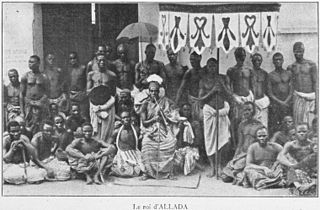
Allada is a town, arrondissement, and commune, located in the Atlantique Department of Benin.

Savalou is a city located in the Collines Department of Benin. The commune covers an area of 2,674 square kilometres and as of 2012 had a population of 35,433 people. It is the birthplace of Olympic Beninese hurdler Odile Ahouanwanou.
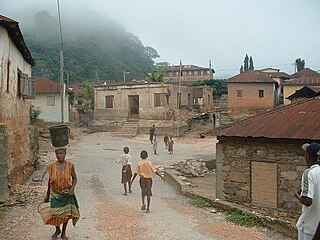
The Logba people live in the Volta Region of Ghana, east of the Volta Lake in the mountains of the Ghana-Togo borderland. Most Logba towns and villages are situated along the trunk road from Accra to Hohoe. They include the following settlements: Wuinta, Akusame, Adiveme, Andokɔfe, Adzakoe, Alakpeti, Klikpo, and Tota. Tota is located high in the Ghana Togo Mountains to the east of the Accra-Hohoe road. Alakpeti is the commercial centre of Logba, while Klikpo is traditionally the seat of the head of the Logba people. The Logba people are primarily subsistence farmers, producing cassava, maize, yams and forest fruits, supplemented by cash crops like cocoa, coffee and sawn mahogany logs. The Logba area is known for its scenery, which includes waterfalls, cliffs, and limestone formations, including one or two known small caves with minor speleothems.

The Aja language is a Gbe language spoken by the Aja people of Benin, Togo, Ghana, Nigeria and Gabon. In Gabon, they are mostly migrants.

Grand-Popo is a town, arrondissement, and commune in the Mono Department of south-western Benin. The commune covers an area of 289 square kilometres and as at the 2013 Census had a population of 57,636 people.
The Kingdom of Ardra, also known as the Kingdom of Allada, was a coastal West African kingdom in southern Benin. While historically a sovereign kingdom, in present times the monarchy continues to exist as a non-sovereign monarchy within the republic of Benin.
Hounkpati B Christophe Capo is a Beninese linguist, and professor of linguistics at the Université d'Abomey-Calavi in the Republic of Benin.
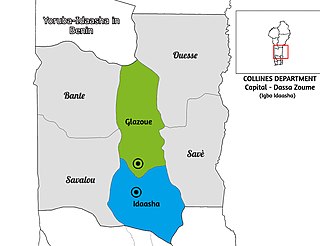
The Idaasha also spelt Idaaca, Idaaṣa and Idaaitsa are a group of the Yoruba people, situated in the central portions of the Collines Department of Benin, West Africa. They are based in and around the communities of Glazoué and Dassa both situated west of the Oueme River. Every year, the Idaasha organize a festival of arts and culture known as FACI to celebrate their culture and heritage, themed Àshà Ìbílẹ̀.











